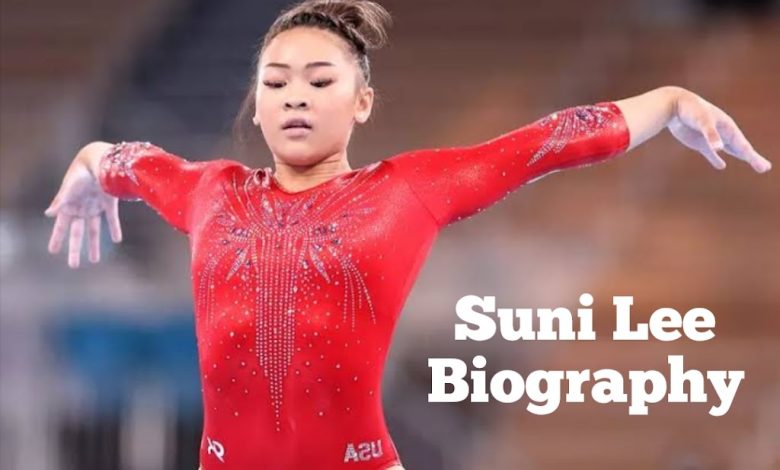Suni Lee Biography: Age, Career and More

Early Life and Introduction to Gymnastics
Sunisa “Suni” Lee was born on March 9, 2003, in St. Paul, Minnesota. The daughter of Hmong immigrants, Suni grew up in a close-knit family that valued hard work and perseverance. Her parents, John Lee and Yeev Thoj, instilled in her a strong sense of cultural pride and determination from a young age.
Suni’s journey into gymnastics began at the tender age of six when her parents noticed her boundless energy and natural athleticism. They enrolled her in classes at Midwest Gymnastics Center in Little Canada, Minnesota, where she quickly caught the eye of coaches with her innate talent and unwavering focus. It was here that Suni’s passion for gymnastics truly blossomed, setting the stage for her remarkable future in the sport.
Rising Through the Ranks
As Suni progressed in her gymnastics training, it became evident that she possessed a rare combination of grace, power, and technical precision. Her coaches, including Jess Graba, recognized her potential and began tailoring her training regimen to nurture her unique abilities. Suni’s dedication to the sport was unparalleled, often spending countless hours in the gym perfecting her routines and pushing the boundaries of her capabilities.
In 2015, at just 12 years old, Suni made her debut in the junior elite ranks. Her performances at various national competitions quickly garnered attention from gymnastics enthusiasts and experts alike. Suni’s intricate bar routines and dynamic floor exercises set her apart from her peers, earning her numerous accolades and establishing her as a rising star in the gymnastics world.
Overcoming Adversity
Suni’s journey to gymnastics stardom was not without its challenges. In 2019, she faced a significant setback when her father, John Lee, suffered a tragic accident that left him paralyzed from the chest down. This devastating event could have derailed Suni’s gymnastics career, but instead, it became a source of motivation and strength for the young athlete.
Despite the emotional toll of her father’s accident, Suni found solace in the gym. She channeled her pain and worry into her training, using it as fuel to push herself even harder. Her father’s unwavering support and encouragement from his hospital bed became a driving force behind Suni’s determination to succeed, not just for herself but for her family as well.
Breaking Through on the Senior Level
In 2019, Suni made her senior debut at the U.S. Gymnastics Championships. Her performances were nothing short of spectacular, showcasing her signature uneven bars routine that would soon become the talk of the gymnastics world. Suni’s innovative combinations and flawless execution earned her a silver medal in the all-around competition, second only to the formidable Simone Biles.
This breakthrough performance catapulted Suni into the spotlight and solidified her place as a contender for the U.S. Olympic team. Her unique skills on the uneven bars, including the “Nabieva” release move and a complex dismount, set her apart from her competitors and earned her the highest difficulty score in the world on this apparatus.
The Road to Tokyo
As the 2020 Tokyo Olympics approached, Suni’s training intensified. However, the global COVID-19 pandemic threw a wrench into her carefully laid plans. With the Olympics postponed to 2021 and gyms closed due to lockdowns, Suni had to adapt her training regimen. She and her coaches got creative, setting up makeshift equipment in her backyard to ensure she could continue honing her skills.
The additional year of preparation proved beneficial for Suni. She used the time to refine her routines, increase her difficulty levels, and work on her mental game. The postponement also allowed her father more time to recover, strengthening their bond and reinforcing his role as her biggest cheerleader.
Olympic Triumph
When the Tokyo Olympics finally arrived in the summer of 2021, Suni was ready to showcase her years of hard work on the world stage. The competition was fierce, with gymnasts from around the globe vying for Olympic glory. Suni’s journey to the all-around final was not without drama, as her teammate and favorite for the gold, Simone Biles, withdrew from the competition citing mental health concerns.
With the weight of expectations on her shoulders, Suni rose to the occasion in spectacular fashion. Her performances across all four apparatuses were a masterclass in precision, artistry, and mental fortitude. Her uneven bars routine, in particular, left spectators and judges in awe. When the final scores were tallied, Suni Lee stood atop the podium, claiming the Olympic all-around gold medal and etching her name in the annals of gymnastics history.
Making History
Suni’s Olympic victory was more than just a personal triumph; it was a landmark moment for the Hmong-American community. As the first Hmong-American to compete in the Olympics, let alone win a gold medal, Suni became an instant role model and source of pride for Hmong people around the world. Her success shone a spotlight on the Hmong community, bringing attention to their rich culture and the challenges they have faced as immigrants in the United States.
Beyond her cultural impact, Suni’s victory also represented a changing of the guard in U.S. women’s gymnastics. Following in the footsteps of gymnastics legends like Simone Biles, Gabby Douglas, and Nastia Liukin, Suni proved that she was ready to carry the torch for the next generation of American gymnasts.
Life After Olympic Glory
In the aftermath of her Olympic success, Suni’s life changed dramatically. She returned home to a hero’s welcome, with parades, ceremonies, and media appearances celebrating her achievements. The young gymnast found herself thrust into the limelight, navigating newfound fame while still processing her incredible Olympic journey.
Eager to explore new opportunities, Suni made the decision to attend Auburn University, where she joined the collegiate gymnastics team. This move allowed her to experience a different side of the sport, competing as part of a team and balancing her athletic pursuits with academic responsibilities. Suni’s presence on the Auburn team brought unprecedented attention to collegiate gymnastics, drawing large crowds and inspiring a new generation of young gymnasts.
Advocacy and Influence
As Suni’s platform grew, so did her commitment to using her voice for positive change. She became an outspoken advocate for mental health awareness in sports, drawing from her own experiences and those of her teammates. Suni’s openness about the pressures faced by elite athletes helped to destigmatize conversations about mental health in the gymnastics community and beyond.
Additionally, Suni has used her position to promote diversity and representation in gymnastics. As a Hmong-American athlete, she has spoken about the importance of visibility for underrepresented communities in sports. Her success has inspired young gymnasts from diverse backgrounds to pursue their dreams, knowing that there is a place for them at the highest levels of the sport.
Looking to the Future
As Suni continues to evolve as an athlete and public figure, the future holds endless possibilities. While she has expressed interest in competing in the 2024 Paris Olympics, she approaches her gymnastics career with a balanced perspective, understanding the importance of prioritizing her physical and mental well-being.
Beyond her athletic pursuits, Suni has shown an interest in fashion and media, hinting at potential career paths outside of gymnastics. Whatever direction she chooses, it’s clear that Suni Lee’s impact will extend far beyond her Olympic achievements. Her journey from a young Hmong-American girl with big dreams to an Olympic champion and cultural icon serves as an inspiration to aspiring athletes and dreamers everywhere.
Legacy and Impact
Suni Lee’s legacy in the world of gymnastics and beyond is still being written, but her impact is already undeniable. She has redefined what is possible on the uneven bars, pushing the boundaries of difficulty and execution. Her unique skills and innovative combinations have inspired gymnasts around the world to explore new possibilities in their routines.
More importantly, Suni’s success has opened doors for greater diversity and representation in gymnastics. Her journey has highlighted the importance of accessibility in sports, encouraging gymnastics programs to reach out to underserved communities and provide opportunities for talented athletes from all backgrounds.
As a role model, Suni exemplifies the values of hard work, perseverance, and grace under pressure. Her ability to overcome personal challenges and perform at the highest level serves as a testament to the power of resilience and determination. For young gymnasts watching her compete, Suni represents the possibility of turning their own dreams into reality through dedication and unwavering commitment to their goals.
Conclusion
Suni Lee’s biography is a testament to the power of dreams, determination, and the unbreakable bond between an athlete and her family. From her humble beginnings in St. Paul to the top of the Olympic podium, Suni’s journey embodies the spirit of perseverance in the face of adversity. Her groundbreaking achievements have not only etched her name in gymnastics history but have also paved the way for greater diversity and representation in the sport.
As Suni continues to evolve as an athlete and individual, her story remains an inspiration to millions around the world. Her legacy extends beyond her medals and accolades, touching the lives of young athletes, the Hmong community, and anyone who dares to dream big. Suni Lee’s biography is far from complete, and the world watches with anticipation to see what this remarkable young woman will accomplish next.






